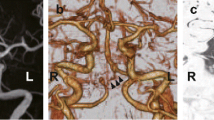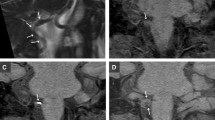Summary
¶ Background. Recently, three-dimensional computed tomographic angiography (CTA) has been used for the diagnosis and treatment planning of cerebral aneurysm presenting with or without subarachnoid haemorrhage, but the diagnostic value of CTA has not been established. This study evaluated the usefulness of CTA in patients with dissecting aneurysms of the vertebrobasilar system.
Method. Four patients with acute dissecting aneurysms were examined by CTA, including 3 women and 1 man with a mean age of 60.5±8.5 years (range: 52–67 years). There were three patients with subarachnoid haemorrhage and one patient presenting with ischaemia. One patient underwent CTA twice and digital subtraction angiography (DSA) once, while one patient had both examinations three times. CTA was performed with a nonionic contrast medium (100 ml of iomeprol 350 mg I/ml) administered via an auto-injector into an antecubital vein at 1.5–1.7 ml/s. To reconstruct three-dimensional images, the volume rendering method was utilized.
Findings. All initial CTA studies were performed safely within 5 hours after onset. In patients with subarachnoid haemorrhage, all lesions were demonstrated by finding either the “pearl and string sign” or a “double shadow” on CTA. In the patient presenting with ischaemia, “pearl and string sign” and “double shadow” was shown after the second CTA, and follow-up CTA was able to demonstrate the change of the lesion morphology. All lesions had more irregular luminal surfaces than the non-lesional segments of the involved vessels.
Interpretation. CTA was safe in patients with acute vertebrobasilar dissection and demonstrated either the “pearl and string sign” or a “double shadow” which were commonly showed on DSA. An “irregular luminal surface sign” on CTA seems to be one of the characteristics of vertebrobasilar dissection.
The view shown by CTA is not less useful than that by DSA to diagnosis and treatment planning in the acute phase of vertebrobasilar dissection, and can also be employed to follow the changes of lesion morphology over time.
Similar content being viewed by others
Author information
Authors and Affiliations
Rights and permissions
About this article
Cite this article
Nakatsuka, M., Mizuno, S. Three-Dimensional Computed Tomographic Angiography in Four Patients with Dissecting Aneurysms of the Vertebrobasilar System. Acta Neurochir (Wien) 142, 995–1001 (2000). https://doi.org/10.1007/s007010070054
Issue Date:
DOI: https://doi.org/10.1007/s007010070054




